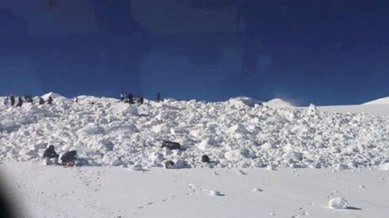Click here to join Express Pune WhatsApp channel and get a curated list of our stories
At COP30, scientists want aggressive action on emissions to save cryosphere
In a study released to coincide with the ongoing COP30 in Brazil, leading cryosphere scientists have said that there is still a small window to prevent the worst-case scenario and provide hope for the cryosphere and the populations that depend on it.

It is a relatively small glacier for Antarctica, but soon, the Hektoria glacier might stop existing altogether. It has lost half its ice in two months. On the polar opposite, Greenland is fast shedding its vast ice sheets. From across the world, the message is unanimous — the planet is losing ice at a record pace as temperatures continue to rise. Left unchecked, this means disaster for billions of people.
In a study, ‘2025 State of the Cryosphere Report’, released on November 6 to coincide with the climate change conference, COP30, in Belem, Brazil, which is being held from November 10 to 21, more than 50 leading cryosphere scientists have said that there is still a small window to prevent the worst-case scenario, and provide hope for the cryosphere and the populations that depend on it.
The report is published by the International Cryosphere Climate Initiative (ICCI), a global network of scientists, researchers, and policy experts working to understand and preserve Earth’s cryosphere.
1.5°C by 2100 is possible
The scenario looks challenging at present. The ICCI report comes at a time when global temperatures are expected to exceed 1.5°C above pre-industrial levels within the next decade. According to the latest United Nations Environment Programme’s Emissions Gap Report, “even if countries live up to their Nationally Determined Contributions (NDCs) to reduce greenhouse gas emissions – and that’s a big ‘if’ – the world will warm by 2.3°C to 2.5°C by the end of the century”.
Even 1°C of warming is enough to disrupt the stability of polar ice sheets, and many glaciers will start melting at a lower temperature. These temperature overshoots are likely to increase cryosphere loss, resulting in higher sea-level rise, impacted water supply, and greater polar ocean acidification.
According to the report, however, proactive climate pathways can bring temperatures down below 1.5°C by 2100 and below the 1°C mark in the next century — but only if aggressive emission cuts begin immediately in 2025 itself.
“Neither the panic nor resignation is necessary. Ice indeed will continue to be irreversibly lost so long as greenhouse gases continue pouring into our atmosphere. That is a physical fact…. an equally physical fact is that there are feasible pathways that address the root fossil fuel causes of global warming, and halt the current global insanity that would lock in thousands of years of human suffering and species loss,” writes Pam Pearson, Director and Founder, ICCI.
Ambitious pathways
The report highlights the measures or Highest Possible Ambition (HPAs) developed by Climate Analytics and the Potsdam Institute that might return temperatures to 1.5°C or below by 2100, even after higher levels of overshoot of 1.7–1.8°C.
The first step is to phase out fossil fuels, beginning with the power and transport sectors, where cost-effective alternatives have already been developed. Fossil fuel phase-out can begin with coal in the 2040s, followed by gas in the 2050s and, then, oil in the 2060s.
Other measures include halting and reversing deforestation, cutting emissions of methane and black carbon from sources such as agriculture and household and waste sectors, and, finally, scaling up land-based carbon dioxide removal to bring about a temperature decline. Reducing emissions alone can have a positive impact on the cryosphere, especially by checking permafrost thaw and reflective sea ice loss.
The measures anticipate a tripling of energy demand by 2050, which is expected to be met by a tripling of all renewables by 2030, a six-time increase by 2035, and a 15-time increase by 2050, based on the rapid expansion of recent years.
“These steps would bring us to net zero greenhouse gas emissions in the 2060s. After that, feasible methods of carbon dioxide removal can bring down temperatures to as low as 1.2°C – lower than today’s temperatures. By 2150, we can be below the 1°C mark that major findings, published just this year, have indicated as the true safe planetary boundary for both ice sheets and mountain glaciers,” writes Pearson.
Click here to join Express Pune WhatsApp channel and get a curated list of our stories